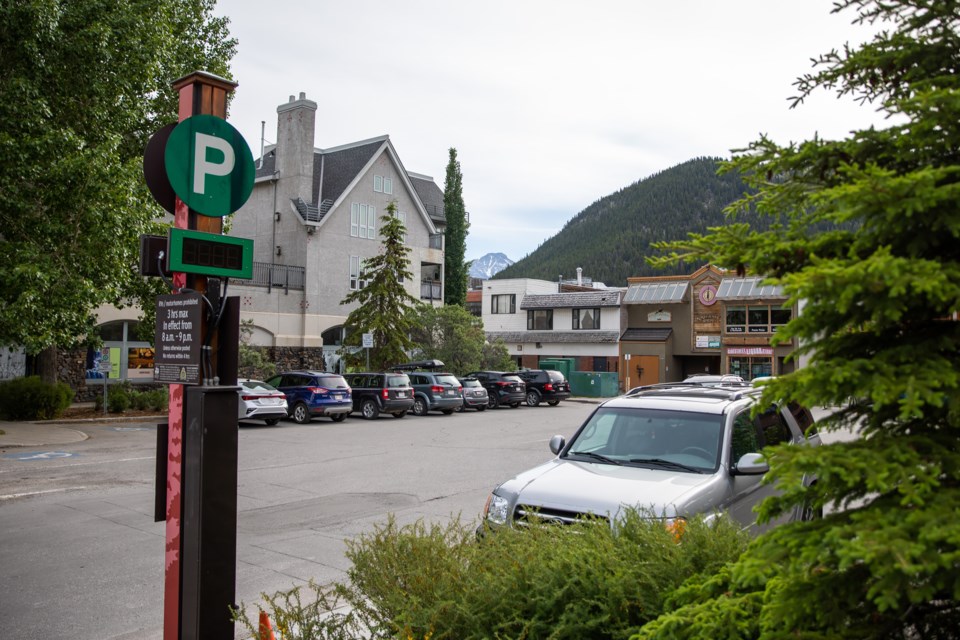BANFF – Banff’s elected officials will likely use net revenues from visitor paid parking to help with tax stabilization and economic recovery as the hard hit tourist town fights its way out of the COVID-19 pandemic.
At a Nov. 8 meeting, Banff’s governance and finance committee directed administration to return to a future council meeting with amendments to the paid parking reserve policy – which stipulates how paid parking profits are spent – to allow for this.
Councillor Barb Pelham supported the spirit of the discussion, noting her support is not just a method to assist businesses, but to help residents given an expected shift in taxation between the residential and commercial sectors.
“It is to protect residents and other small businesses from facing an enormous tax increase to fill a hole that will be left by the COVID drop in hotel revenue, which results in a drop in the taxes paid by hotels,” she said.
After almost two decades of debate and two plebiscites later, the Town of Banff introduced visitor pay parking in the downtown core in early July this year. It costs $3 per hour to park from May 1 to Oct. 31 and drops to $2 per hour throughout winter.
Banff residents who have a parking permit can park for free for up to three hours per day in the paid zone if they have registered their license plates with the municipality.
Gross revenue for 2021 is estimated at $1.3 million, but net revenues will be about $162,000 given the high start-up costs to run the visitor paid parking and residential permit system, including capital spends to provide power, concrete bases, machines and signage.
The operating expenses are estimated at $382,260 for this year, while the capital costs are projected to be $755,000.
Future paid parking profit is estimated at $1.58 million in 2022, $1.75 million in 2023 and $1.82 million in 2024.
Currently, Banff’s paid parking reserve policy stipulates where net revenues from paid parking must go.
The previous council directed profits fund operating or capital costs related to roadway and parking improvements, transit enhancements, increased snow clearing, cycling or other active transportation initiatives and transportation decarbonization projects.
Newly elected Councillor Hugh Pettigrew was unsuccessful in his attempt to get his council colleagues to agree that 100 per cent of net revenues go towards tax stabilization.
“I want to temporarily direct net visitor paid parking revenues 100 per cent towards budget stabilization until such time that we feel that the economic crisis is over,” he said, noting council should not fund other initiatives listed in the paid parking reserve fund at this point.
“My preference would be …that we direct these funds to tax stabilization so that council would have the leeway to take it out to fix the problems that we may see with the coming tax rate.”
However, most other councillors preferred to have more flexibility in the upcoming 2022 service review and budget deliberations, by simply adding budget stabilization and economic recovery as options in the reserve policy.
“It doesn’t say that 100 per cent of the net revenue of paid parking wouldn’t go to tax stabilization, but it could be a different amount,” said Coun. Chip Olver.
“I think we need to get further into service review, further into our budget process and then look at how much goes where.”
Administrative officials say visitor paid parking and the residential parking permit system achieved its goals by filling the train station intercept lot, freeing up parking space in residential areas and downtown, and allowing free time for residents to run errands.
Adrian Field, the Town of Banff’s director of engineering, said peak occupancy at the approximately 500-stall intercept parking lot at the train station reached the municipality’s strategic plan target of greater than 80 per cent.
While displacing visitors from residential areas to intercept parking was one of the goals, he said one negative consequence is that options for visitor parking are more limited when the intercept lot, downtown and peripheral parking spaces are full.
“In order to accommodate future visitor volumes then a continued shift to mass transit – ideally from Calgary – will be required,” said Field.
Summer 2021 vehicle volumes increased 15 per cent from 2020 but were 18 per cent below pre-pandemic levels in 2019.
There were 16 days this summer when Banff’s congestion threshold of 24,000 vehicles per day was exceeded, compared to one day in 2020 and all 62 days in summer 2019. The maximum daily volume in 2021 was 30,053.
“Despite the lack of international travel for most of the summer, Banff experienced higher traffic volumes versus 2020, and higher demand for parking,” said Field.
“Along with resumption in visitation and accompanying vehicle volume increases in future years traffic congestion and travel time delays can be expected,” he added
“Continued proactive development and deployment of strategies and tactics to manage traffic volume will be required.”
Administration will return in fall 2022 with a report on the visitor paid parking and residential parking permit system after a full year of operation, including any recommendations for potential changes for council’s consideration.




